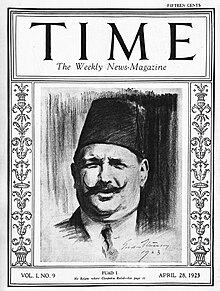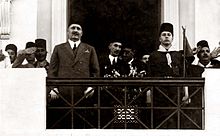Fu'ad I.
Fu'ad I. , full name Ahmad Fuad I. Pascha , ( Arabic فؤاد الأول Fu'ad al-awwal , DMG Fuʾād al-auwal , Turkish Fuad or Ahmed Fuad Paşa , oftentranscribedas Fuad ; * March 26, 1868 in Cairo ; † April 28, 1936 ibid) from the dynasty of Muhammad Ali was the ninth ruler of Egypt and Sudan from this dynastyfrom 1917 to 1936.
In 1917 he ascended the throne of the Sultanate of Egypt after the death of Hussein Kamil . After independence from Great Britain , he became king of Egypt and Sudan in 1922 .
Fu'ad was conservative and rejected parliamentary democracy in Egypt. Nevertheless, his accession as king meant a certain liberalization and many social freedoms. Because of his rejection of the continuing British influence, he gained great popularity in the kingdom. His reign was largely shaped by the activities of the nationalist Wafd party , which pushed Egypt's economic modernization and often came into conflict with the monarch. Fu'ad I's successor was his son Faruq I , who was crowned second king in 1937.
Earlier years
Fu'ad was born in 1868 in the Giza Palace in Cairo as the seventh son of the Khedive of the Ottoman Khedivat Egypt Ismail Pasha . His mother was Farial Kadin.
Before his unforeseen accession to the throne, the prince played an important role in creating Cairo University . He became the first university rector in 1908 and remained in office until his resignation in 1913. In the same year he tried unsuccessfully to sit on the throne of Albania , which had obtained its independence from the Ottoman Empire . At the time, Egypt and Sudan were ruled by his nephew Abbas II and the fact that Fu'ad was far behind in the line of succession encouraged him to do so. From 1915 to 1918, Fu'ad served as President of the Egyptian Geographic Society .
Marriage and children
Fu'ad married his first wife on May 30, 1895 in the Abbasiya Palace in Cairo. It was the influential Turkish aristocrat Shivakiar Khanum Effendi . The couple had two children, including a son, Ismail Fu'ad, who died shortly after he was born in 1896, and a daughter, Fawkia, in 1897. In 1898 the couple separated after a violent argument.
The monarch married his second wife in the Bustan Palace in Cairo on May 24, 1919. She was Nazli Sabri (1894–1978), daughter of a politically and economically influential Egyptian aristocratic family. The couple had five children, including the future King Faruq and four daughters.
As with his first wife, Fu'ad's relationship with his second wife was also stormy. The couple argued constantly, and Fu'ad even forbade Nazli to leave the palace.
-
Shivakiar Khanum Effendi (1876-1947)
-
children
- Ismail Fu'ad (1896-1896)
- Fawkia (1897–1974)
-
children
- Nazli Sabri (1894–1978)
Domination


Fu'ad I. ascended the throne of the Sultanate of Egypt (British protectorate since its establishment in 1914 ) after the death of his brother Hussein Kamil on October 9, 1917. At first he ruled largely constitutionally and implemented some liberal reforms. His initial rule was marked by increasing tensions with the British colonial power, which had been fighting the Ottoman Empire from Egypt since 1914 .
The end of the First World War sparked a revolution in 1919 that campaigned for Egypt's independence and more democracy . The survey covered the whole country and Fu'ad I. sat at its head, which earned him the recognition of large sections of the population.
In the period after the revolution of 1919, the British ended the protectorate over Egypt and recognized it as a sovereign state with the declaration of Egypt's independence on February 28, 1922. Despite certain restrictions of the new independence, Fu'ad I. took advantage of the nationalist elation and proclaimed himself the first King of Egypt and ruler of Sudan on March 15, 1922 with a decree . His new empire , which was one of the largest contiguous independent states in the world, went through a period of important social, political and economic reforms.
In the spring of 1923, a new sealed Constitution , the parliamentary democracy . The king rejected this, despite his still strong constitutional position, and got involved in day-to-day political affairs more often than the mostly ruling Wafd party would have liked. After a serious crisis with Great Britain in November 1924 over the status of jointly administered Sudan , the monarch dissolved the parliament on December 24th, which had only been elected in January 1924 , and dismissed the popular Prime Minister Saad Zaghlul . This was followed by the most unstable minority governments and only a few legislative sessions of Parliament. Nevertheless, Egypt quickly managed to industrialize and at least bring the standard of living in the cities closer to the European level. Fu'ad received support from the Rockefeller Foundation to help build the health care system . There was also radical secularization , which the more moderately conservative king tolerated. He also had to accept the cession of large areas to the Italian colony of Libya and French Chad between 1926 and 1934. After the Ottoman caliphate was abolished by the Turkish parliament in March 1924, leading scholars from Azhar University wanted to proclaim Fu'ad I as the new caliph in an international congress. However, the Hashimite king Husain ibn Ali of the Kingdom of Hejaz got ahead of this and was proclaimed the new caliph by a group of ulama . However, his claim to power was not recognized internationally.
In June 1928 Fu'ad I. triggered a state crisis . First he dismissed the then Prime Minister Mustafa an-Nahhas Pascha , who had risen to become the new Wafd party leader in 1927. On July 19, the king suspended the constitution indefinitely and dissolved parliament. Without formally reinstating the constitution, he announced new elections in December 1929, which brought the Wafd party a major victory. Mustafa an-Nahhas was again prime minister, but was deposed again by Fu'ad I on June 17, 1930 after he had tried to restrict the power of the king through two bills in parliament.
From 1930 on, extremist forces such as the Islamist Muslim Brotherhood , founded in 1928 by Hasan al-Bannā , and the ultra-nationalist Young Egyptian Party, founded in 1933, increasingly threatened the rule of the king in the course of the global economic crisis . They rejected the secular and democratic state order and began to destabilize the kingdom with attacks and staged uprisings. When the National Socialists came to power in the German Reich in 1933, fascism also germinated in Egypt . The Egyptian government then leaned increasingly on the fascist powers of the Kingdom of Italy and the German Empire . Fu'ad I. condemned the allegiance to Germany because of the radical anti-Semitism there . During the Italian invasion of Ethiopia on October 3, 1935, he held back. Because of the great domestic and foreign political threat, the monarch appointed Ismail Sedki Pasha Prime Minister in 1930 to ensure stability . With the tacit consent of the king, he established a dictatorship . In July 1930, parliament was again suspended, press censorship was introduced, and the work of political parties and freedom of assembly were restricted. In October, Sedki issued a new constitution strengthening his and the crown's power. Parliament's role has been limited to consultative status. Large-scale demonstrations forced Fu'ad I. initially to dismiss Sedki in 1933 and finally to restore the previous constitution in December 1935.
death
Discredited by the Sedki dictatorship, Fu'ad I. withdrew completely from day-to-day politics shortly before his death. On January 30, 1936, he appointed Ali Maher Pasha from the Wafd party as prime minister. The king died on April 28, 1936 at the age of 68 in the Qubba Palace in Cairo. After a pompous state funeral, he was buried in the Khedive mausoleum in the ar-Rifa'i mosque in Cairo. He was succeeded by Faruq , who had to return to Egypt from his officer training from Great Britain.
Web links
- الملك أحمد فؤاد الأول (entry on Fu'ad I. in the digital Memory of Modern Egypt of the Bibliotheca Alexandrina ; Arabic)
- Newspaper article about Fu'ad I. in the 20th century press kit of the ZBW - Leibniz Information Center for Economics .
Individual evidence
- ↑ Hassan Hassan: In the House of Muhammad Ali: A Family Album, 1805-1952. American Univ. in Cairo Press. 2000. ISBN 978-977-424-554-1 ., From p. 9.
- ^ Dolf Sternberger , Bernhard Vogel , Dieter Nohlen , Klaus Landfried (eds.): The election of parliaments and other state organs. Volume II: Africa: Political Organization and Representation in Africa. De Gruyter, 1978, ISBN 978-3-11-004518-5 , p. 250.
- ↑ Ferdinand Sauerbruch , Hans Rudolf Berndorff : That was my life. Kindler & Schiermeyer, Bad Wörishofen 1951; cited: Licensed edition for Bertelsmann Lesering, Gütersloh 1956, pp. 322-324 (on Sauerbruch's stay in Egypt as a guest lecturer and advisor to the king at the end of 1930).
- ↑ See Martin Kramer: Islam assembled. The Advent of the Muslim Congress . New York 1986. pp. 86-105.
- ^ Dolf Sternberger, Bernhard Vogel, Dieter Nohlen, Klaus Landfried (eds.): The election of parliaments and other state organs / Volume II: Africa: Political organization and representation in Africa De Gruyter, 1978, ISBN 978-3-11-004518- 5 , p. 251.
- ^ Dolf Sternberger, Bernhard Vogel, Dieter Nohlen, Klaus Landfried (eds.): The election of parliaments and other state organs / Volume II: Africa: Political organization and representation in Africa De Gruyter, 1978, ISBN 978-3-11-004518- 5 , p. 252.
| predecessor | Office | successor |
|---|---|---|
| Hussein Khamil |
Sultan of Egypt from 1922, King 1917–1936 |
Faruq |
| personal data | |
|---|---|
| SURNAME | Fu'ad I. |
| ALTERNATIVE NAMES | Pasha, Ahmad Fuad I .; Paşa, Fuad or Ahmed Fuad; فؤاد الأول (Arabic) |
| BRIEF DESCRIPTION | ninth ruler of Egypt and Sudan (1917–1936) |
| DATE OF BIRTH | March 26, 1868 |
| PLACE OF BIRTH | Cairo |
| DATE OF DEATH | April 28, 1936 |
| PLACE OF DEATH | Cairo |




